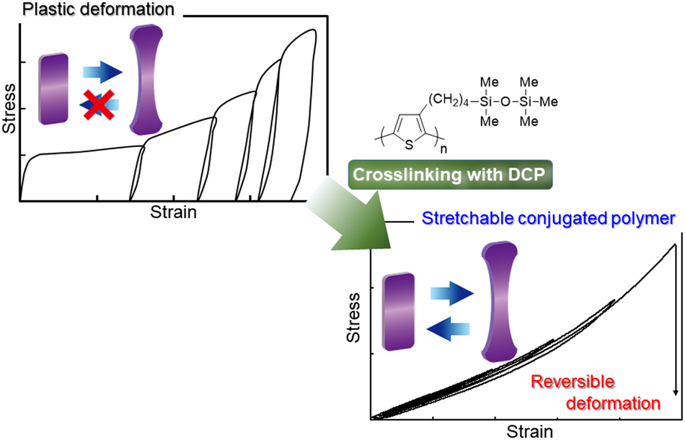Our official English website, www.x-mol.net, welcomes your feedback! (Note: you will need to create a separate account there.)
Fabrication and characterization of elastomeric semiconductive thiophene polymers by peroxide crosslinking
Polymer Journal ( IF 2.8 ) Pub Date : 2018-10-17 , DOI: 10.1038/s41428-018-0137-4 Jian Shen , Iori Sugimoto , Takuya Matsumoto , Shohei Horike , Yasuko Koshiba , Kenji Ishida , Atsunori Mori , Takashi Nishino
Polymer Journal ( IF 2.8 ) Pub Date : 2018-10-17 , DOI: 10.1038/s41428-018-0137-4 Jian Shen , Iori Sugimoto , Takuya Matsumoto , Shohei Horike , Yasuko Koshiba , Kenji Ishida , Atsunori Mori , Takashi Nishino

|
AbstractIn this study, semiconductive elastomers composed of homopolythiophene with disiloxane moieties were developed. The crosslinked molecular structure in the polythiophene elastomers was introduced by dicumyl peroxide, one of the typical peroxide crosslinking reagents. The elastomers were produced through a hot-pressing process above the melting point of the polythiophene. Stress–strain curves that included tensile tests and cycle loading–unloading tests defined the crosslinked polythiophenes as elastomers. Their electrical conductivities were evaluated by two-point measurements under nondeformation and uniaxial deformation states. The results indicated that the concentration of crosslinking reagents greatly influenced the mechanical and electrical properties of crosslinking polymers. With the addition of the crosslinking reagent in concentrations from 2.5 phr to 10.0 phr, elongation at break decreased largely from 95% to 51%, while excellent elastic recoveries were observed. In the electrical resistivity measurements, all the crosslinking polymers possessed high stability of electrical properties against elongation.We crosslinked polythiophenes with disiloxane groups in its side chains by dicumyl peroxide. The crosslinked polythiophenes maintained low glass transition temperatures and low Young’s modulus, while they emerged high elastic recoveries. Moreover, as the concentration of dicumyl peroxide increased, the crosslinked polythiophenes possessed higher elastic recoveries. We obtained completely elastic semiconductive polythiophenes.
中文翻译:

通过过氧化物交联制备和表征弹性半导体噻吩聚合物
摘要 本研究开发了由均聚噻吩和二硅氧烷部分组成的半导体弹性体。聚噻吩弹性体中的交联分子结构是通过过氧化二枯基引入的,过氧化二异丙苯是典型的过氧化物交联剂之一。弹性体是通过高于聚噻吩熔点的热压工艺生产的。包括拉伸试验和循环加载-卸载试验在内的应力-应变曲线将交联聚噻吩定义为弹性体。通过在非变形和单轴变形状态下的两点测量来评估它们的电导率。结果表明,交联剂的浓度对交联聚合物的机械和电学性能有很大影响。添加浓度为 2.5 phr 至 10.0 phr 的交联剂后,断裂伸长率从 95% 大幅降低至 51%,同时观察到出色的弹性恢复。在电阻率测量中,所有的交联聚合物都具有较高的电性能对伸长率的稳定性。我们用过氧化二枯基交联了侧链上带有二硅氧烷基团的聚噻吩。交联聚噻吩保持低玻璃化转变温度和低杨氏模量,同时它们出现高弹性恢复。此外,随着过氧化二枯基浓度的增加,交联聚噻吩具有更高的弹性恢复。我们获得了完全弹性的半导体聚噻吩。同时观察到优异的弹性恢复。在电阻率测量中,所有的交联聚合物都具有较高的电性能对伸长率的稳定性。我们用过氧化二枯基交联了侧链上带有二硅氧烷基团的聚噻吩。交联聚噻吩保持低玻璃化转变温度和低杨氏模量,同时它们出现高弹性恢复。此外,随着过氧化二枯基浓度的增加,交联聚噻吩具有更高的弹性恢复。我们获得了完全弹性的半导体聚噻吩。同时观察到优异的弹性恢复。在电阻率测量中,所有的交联聚合物都具有较高的电性能对伸长率的稳定性。我们用过氧化二枯基交联了侧链上带有二硅氧烷基团的聚噻吩。交联聚噻吩保持低玻璃化转变温度和低杨氏模量,同时它们出现高弹性恢复。此外,随着过氧化二枯基浓度的增加,交联聚噻吩具有更高的弹性恢复。我们获得了完全弹性的半导体聚噻吩。我们通过过氧化二异丙苯交联了侧链上带有二硅氧烷基团的聚噻吩。交联聚噻吩保持低玻璃化转变温度和低杨氏模量,同时它们出现高弹性恢复。此外,随着过氧化二枯基浓度的增加,交联聚噻吩具有更高的弹性恢复。我们获得了完全弹性的半导体聚噻吩。我们通过过氧化二异丙苯交联了侧链上带有二硅氧烷基团的聚噻吩。交联聚噻吩保持低玻璃化转变温度和低杨氏模量,同时它们出现高弹性恢复。此外,随着过氧化二枯基浓度的增加,交联聚噻吩具有更高的弹性恢复。我们获得了完全弹性的半导体聚噻吩。
更新日期:2018-10-17
中文翻译:

通过过氧化物交联制备和表征弹性半导体噻吩聚合物
摘要 本研究开发了由均聚噻吩和二硅氧烷部分组成的半导体弹性体。聚噻吩弹性体中的交联分子结构是通过过氧化二枯基引入的,过氧化二异丙苯是典型的过氧化物交联剂之一。弹性体是通过高于聚噻吩熔点的热压工艺生产的。包括拉伸试验和循环加载-卸载试验在内的应力-应变曲线将交联聚噻吩定义为弹性体。通过在非变形和单轴变形状态下的两点测量来评估它们的电导率。结果表明,交联剂的浓度对交联聚合物的机械和电学性能有很大影响。添加浓度为 2.5 phr 至 10.0 phr 的交联剂后,断裂伸长率从 95% 大幅降低至 51%,同时观察到出色的弹性恢复。在电阻率测量中,所有的交联聚合物都具有较高的电性能对伸长率的稳定性。我们用过氧化二枯基交联了侧链上带有二硅氧烷基团的聚噻吩。交联聚噻吩保持低玻璃化转变温度和低杨氏模量,同时它们出现高弹性恢复。此外,随着过氧化二枯基浓度的增加,交联聚噻吩具有更高的弹性恢复。我们获得了完全弹性的半导体聚噻吩。同时观察到优异的弹性恢复。在电阻率测量中,所有的交联聚合物都具有较高的电性能对伸长率的稳定性。我们用过氧化二枯基交联了侧链上带有二硅氧烷基团的聚噻吩。交联聚噻吩保持低玻璃化转变温度和低杨氏模量,同时它们出现高弹性恢复。此外,随着过氧化二枯基浓度的增加,交联聚噻吩具有更高的弹性恢复。我们获得了完全弹性的半导体聚噻吩。同时观察到优异的弹性恢复。在电阻率测量中,所有的交联聚合物都具有较高的电性能对伸长率的稳定性。我们用过氧化二枯基交联了侧链上带有二硅氧烷基团的聚噻吩。交联聚噻吩保持低玻璃化转变温度和低杨氏模量,同时它们出现高弹性恢复。此外,随着过氧化二枯基浓度的增加,交联聚噻吩具有更高的弹性恢复。我们获得了完全弹性的半导体聚噻吩。我们通过过氧化二异丙苯交联了侧链上带有二硅氧烷基团的聚噻吩。交联聚噻吩保持低玻璃化转变温度和低杨氏模量,同时它们出现高弹性恢复。此外,随着过氧化二枯基浓度的增加,交联聚噻吩具有更高的弹性恢复。我们获得了完全弹性的半导体聚噻吩。我们通过过氧化二异丙苯交联了侧链上带有二硅氧烷基团的聚噻吩。交联聚噻吩保持低玻璃化转变温度和低杨氏模量,同时它们出现高弹性恢复。此外,随着过氧化二枯基浓度的增加,交联聚噻吩具有更高的弹性恢复。我们获得了完全弹性的半导体聚噻吩。



























 京公网安备 11010802027423号
京公网安备 11010802027423号